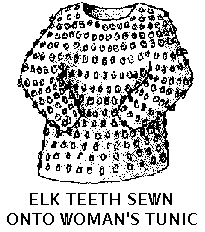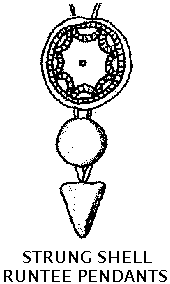
Beauty aside, wearing or presenting jewelry had many social, economic, political and religious implications for the Native Americans of the 1600’s in southern New England. Jewelry was used to show connection with a particular group. Beads validated treaties and were used to remember oral tradition, as well as for exchange and currency. There were many ritual aspects of beads and pendants used in ceremonies of dance, curing and sacrifice. Jewelry was also used in many ‘rites of passage’ which individuals passed through in their lives.
Personal Aesthetics:

| Native Americans in New England, especially young women, enhanced their dress with beads and pendants. Wampum beads were treasured possessions and elaborate types and large amounts of jewelry were worn. Native American women, however, were considered less vain than European women. Besides jewelry, beads decorated clothing or were inlaid into objects of wood for aesthetic beauty. Wampum inlaid wooden items included tomahawk handles, pendants, and native bread mixing bowls. |
Group Identity:
Among many northeastern tribes, individuals acquired a spiritual totem at adolescence, often a mammal, snake, bird, claw, tooth or other animal part which was henceforth carried with that individual. Personal totems often coincided with those of a person’s family, clan or society. Jewelry was a means for Native Americans to show they belonged to that group. A male cat’s head wrapped in trade cloth was one such totem. Totems were used in divination and to ensure opportunity. Native Americans wore beads and pendants to show ingredients in their social lives, economic and political concerns, and in beliefs of cosmology and religion.
Exchange and Currency:

| In New England, wampum beads were part of an economy of reciprocity and gift exchange. Reciprocal gift giving cemented ties between Native Americans. Wampum beads and pendants adorned high status men and young women of a tribe. The similarity in design, and abundance of shell pendants, at both coastal and inland areas attests to Native American networks of regional trade. |
With the volume of trade after European contact, eastern Native Americans traded wampum inland to Wisconsin and the Dakotas, and as far south as Virginia. Using shell, glass and metal beads, early colonists and Native Americans could barter for the products of the other. European traders and politicians, using beads and trinkets, often exploited gift exchange to gain Native American favor or lands. Wampum quickly evolved into a formal currency. A fathom of white beads was worth 10 shillings and double that for purple beads. The wampum embroidered clothing of King Philip was valued at twenty pounds. Metal coins were scarce and wampum became currency for both colonists and Native Americans. Wampum was even mass-produced by the Dutch, and remained in use until the American Revolution.
Ceremonies:
Native Americans in New England integrated beads and pendants into many of their ceremonies. Beads and pendants of natural materials were often used in ritual expression because of Native American esteem placed upon minerals and metals of the earth, and the association of shells with water. Dance ceremonies celebrated the change in seasons, harvest, births, marriages, or commemorated less fortunate events, and were often accompanied by chanting. Native Americans took great pains in the preparation of their appearance and accessories. Dances were often accompanied by throwing out wampum to onlookers. Beads were often distributed and redistributed during Native American dance ceremonies.
Ceremonies of healing and curing often required the use of specific types of jewelry or ornamentation. Shells of many animals, including turtles, were utilized in healing ceremonies. Some New England Native American necklaces provided protection from particular disorders. Face-painting using red, and hair ornaments of that color are also associated with curing ceremonies. Jewelry worn and other personal objects used in southern New England dance ritual were often relinquished or destroyed in sacrifice.
Rites of Passage:
Jewelry was worn or exchanged by Native Americans to indicate that individual had passed through an important physical or social change. These transformations are called rites of passage. Such a change was after a Native American woman had her first menses, when she wore a garment which covers head and body for several months. After this time the women may remove the veil and dress themselves with necklaces, belts, and wampum headbands. Beads were also used in marriage rituals. Bridal presents, including wampum, Dutch glass and other beads were given to a woman for bridal present, which if she accepts, conceded to marry the man. Some bridal presents consisted of five to ten fathoms of wampum. Beads were also incorporated into Native American funeral and mortuary customs in southern New England. The deceased often wore necklaces, bracelets, rings, headband, and other ornaments provided by relatives.

|
Text and Graphics
© 1994 - Tara Prindle unless otherwise cited. |